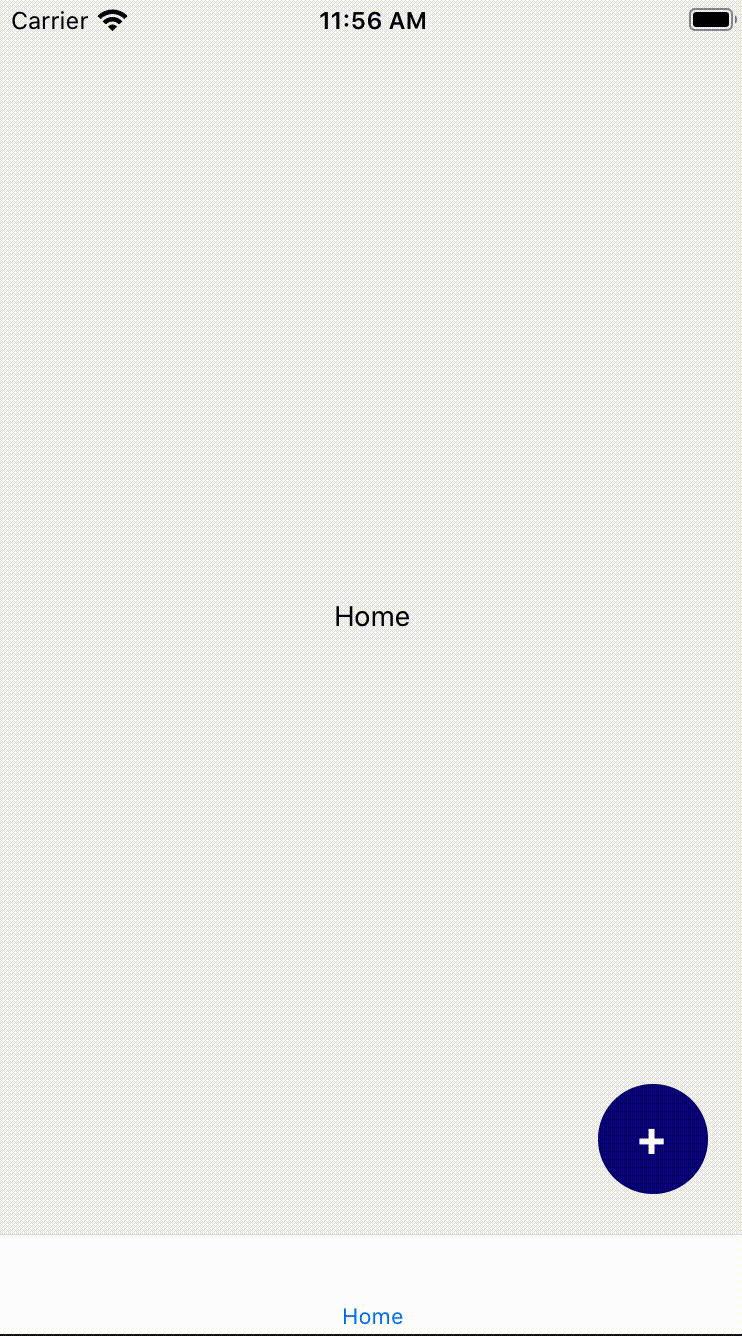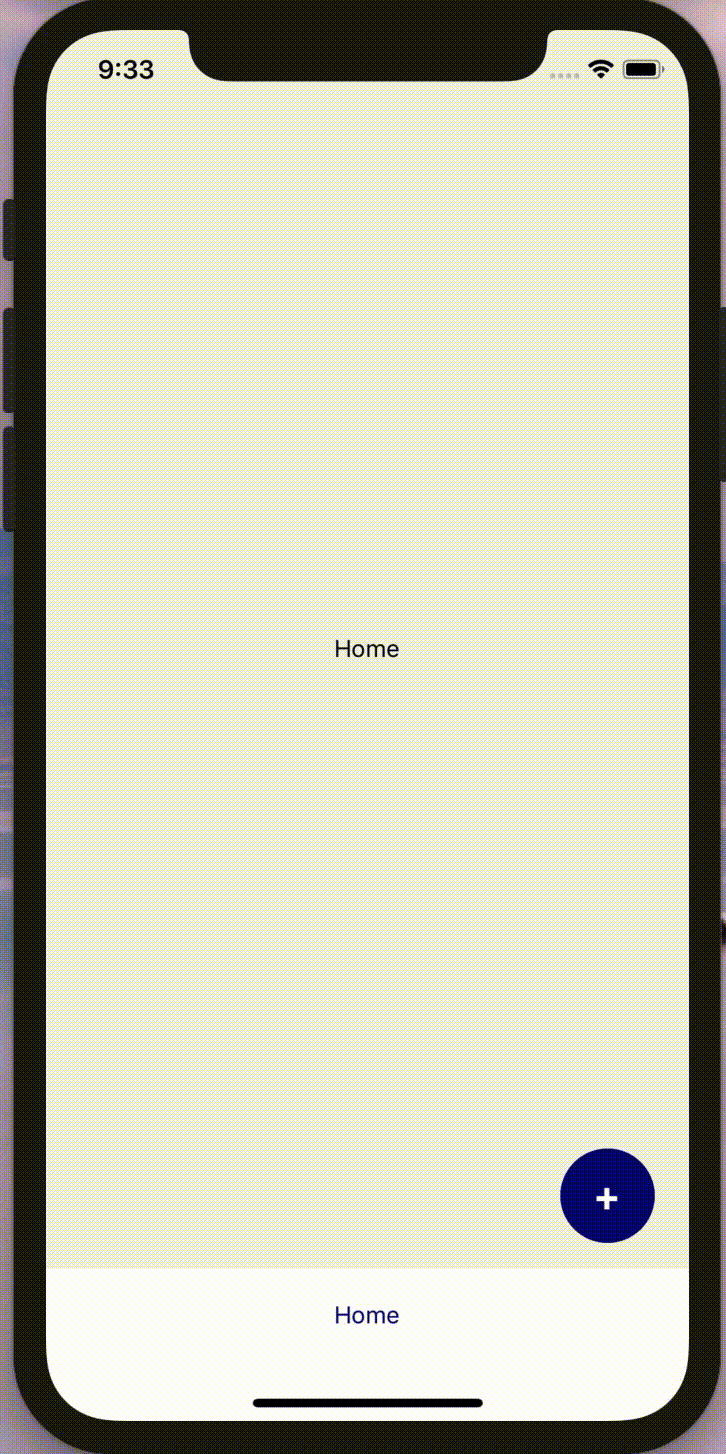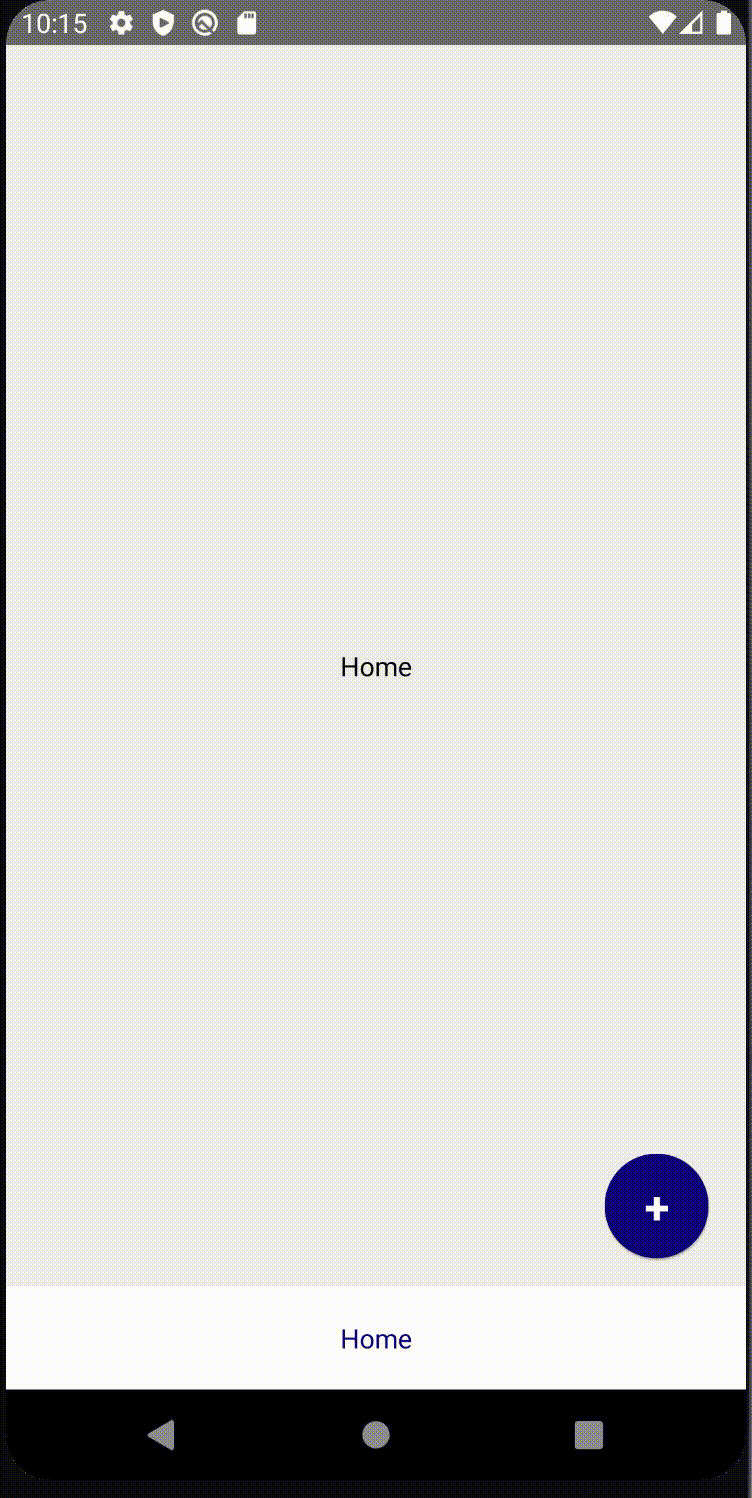RN 屏幕转换:创建一个可转换为屏幕的按钮
让我们开始吧
屏幕变换动画
按钮动画
将 AddButton 放在标签栏中
iPhone 10+ 的插图
我最近在 AppStore 和 PlayStore 上发布了一款名为Sweepy的 React Native 应用。在开发过程中,我在 Twitter 上分享了我的开发进度。我对那条展示这个动画的推文印象非常深刻: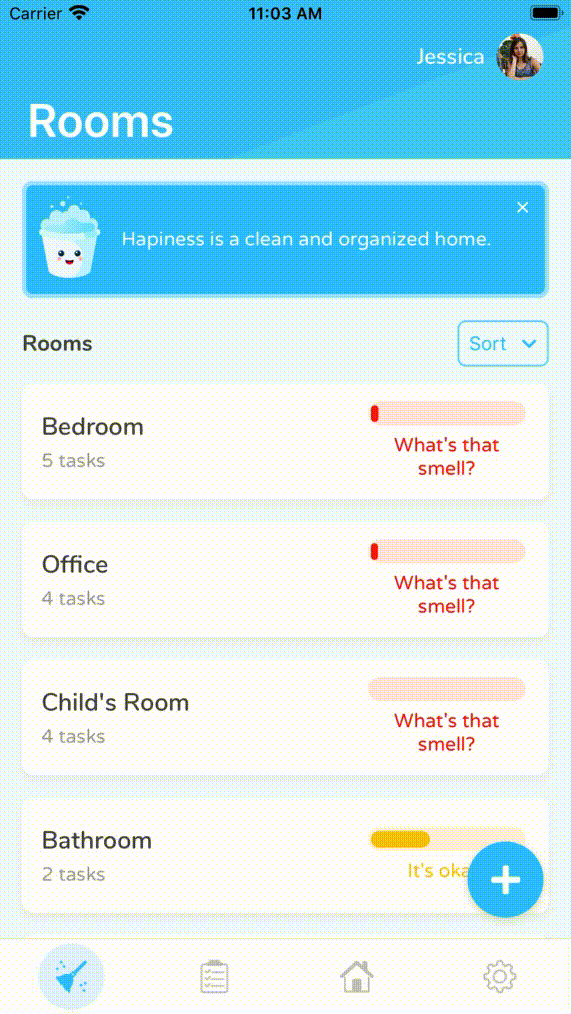
在今天的文章中,我将向你展示我是如何做到这一点的。如果你太忙没时间阅读,想直接看最终的代码,这里有我创建的GitHub 仓库。在我的教程中,我放慢了所有 GIF 的播放速度,以便你更好地观看动画。
让我们开始吧
让我们初始化我们的项目。我将使用 TypeScript 编写代码。如果您对如何使用 TypeScript 和 Airbnb linter 设置 React Native 项目感兴趣,可以查看我的另一篇教程。
首先,我们安装 react-navigation 及其依赖项:
yarn add @react-navigation/native react-native-reanimated react-native-gesture-handler react-native-screens react-native-safe-area-context @react-native-community/masked-view
我们将使用底部标签导航器,因此让我们安装@react-navigation/bottom-tabs 以及@react-navigation/stack:
yarn add @react-navigation/bottom-tabs @react-navigation/stack
如果您为 iOS 开发,请不要忘记运行 pod install。
cd ios && pod install
让我们从 App.tsx 开始。首先在文件顶部导入“react-native-gesture-handler”,并创建一个路由器。如您在示例中所见,我设置了一个堆栈导航器,其中包含一个 BottomTabNavigator 和一个模态屏幕,它们都位于同一个根堆栈中。
import 'react-native-gesture-handler';
import React from 'react';
import { NavigationContainer } from '@react-navigation/native';
import { createBottomTabNavigator } from '@react-navigation/bottom-tabs';
import { createStackNavigator } from '@react-navigation/stack';
import { View, Text } from 'react-native';
type TabBarStackParamList = {
Home: undefined,
}
type RootStackParamList = {
TabBar: TabBarStackParamList,
Modal: undefined,
}
const HomeScreen = () => (
<View style={{ flex: 1, justifyContent: 'center', alignItems: 'center' }}>
<Text>Home</Text>
</View>
);
const ModalScreen = () => (
<View style={{
flex: 1, justifyContent: 'center', alignItems: 'center', backgroundColor: 'navy',
}}
>
<Text>Modal</Text>
</View>
);
const TabBarStack = createBottomTabNavigator<TabBarStackParamList>();
const TabBarStackScreen = () => (
<TabBarStack.Navigator>
<TabBarStack.Screen name="Home" component={HomeScreen} />
</TabBarStack.Navigator>
);
const RootStack = createStackNavigator<RootStackParamList>@();
// we are nesting TabBarStack in RootStack as a screen
const App = () => (
<NavigationContainer>
<RootStack.Navigator headerMode="none" mode="modal">
<RootStack.Screen name="TabBar" component={TabBarStackScreen} />
<RootStack.Screen name="Modal" component={ModalScreen} />
</RootStack.Navigator>
</NavigationContainer>
);
export default App;
现在让我们添加一个按钮来启动模态窗口。我会把它放在一个单独的文件夹中:src/components/add-button/index.tsx:
import React from 'react';
import { TouchableOpacity, Text, StyleSheet } from 'react-native';
// I put the button in absolute position because I want it to be on top of everything behind it
const styles = StyleSheet.create({
container: {
backgroundColor: 'navy',
width: 55,
height: 55,
borderRadius: 28,
position: 'absolute',
right: 20,
alignItems: 'center',
justifyContent: 'center',
bottom: 20,
zIndex: 1,
elevation: 1,
},
text: {
color: 'white',
fontSize: 24,
fontWeight: 'bold',
},
});
type AddButtonProps = {
onAdd: () => void,
}
const AddButton = ({ onAdd } : AddButtonProps) => (
<TouchableOpacity
style={styles.container}
onPress={onAdd}
>
<Text style={styles.text}>
+
</Text>
</TouchableOpacity>
);
export default AddButton;
如你所见,我们的按钮有一个名为 onAdd 的 prop。点击按钮后,此函数将被调用。现在,我们将此 AddButton 组件添加到主屏幕:
// in App.tsx
...
import { NavigationContainer, CompositeNavigationProp } from '@react-navigation/native';
import { createBottomTabNavigator, BottomTabNavigationProp } from '@react-navigation/bottom-tabs';
import { createStackNavigator, StackNavigationProp } from '@react-navigation/stack';
import AddButton from './src/components/add-button';
...
type TabBarStackParamList = {
Home: undefined,
}
type RootStackParamList = {
TabBar: TabBarStackParamList,
Modal: undefined,
}
interface HomeScreenProps {
navigation: CompositeNavigationProp<
BottomTabNavigationProp<TabBarStackParamList, 'Home'>,
StackNavigationProp<RootStackParamList>
>;
}
// I hope I did all type checking properly.
// If not, let me know in the comment section.
const HomeScreen = ({ navigation }: HomeScreenProps) => {
const onAdd = () => {
navigation.navigate('Modal');
};
return (
<>
<View style={{ flex: 1, justifyContent: 'center', alignItems: 'center' }}>
<Text>Home</Text>
</View>
<AddButton onAdd={onAdd} />
</>
);
};
...
屏幕变换动画
现在,我们将编写一个自定义屏幕过渡效果,用于两个屏幕(主屏幕和模态窗口)之间的切换。我们希望实现淡入淡出动画,这样当屏幕打开或关闭时,透明度也会随之改变。为此,我们将使用RootStack.Navigator中的screenOptions属性。
// in App.js
...
const opacityTransition: object = {
gestureDirection: 'horizontal', // we will swipe right if we want to close the screen;
transitionSpec: {
open: {
animation: 'timing',
},
close: {
animation: 'timing',
config: {
duration: 300,
},
},
},
cardStyleInterpolator: ({ current } : {current: {progress: number}}) => ({
cardStyle: {
opacity: current.progress,
}, // updates the opacity depending on the transition progress value of the current screen
}),
};
...
const App = () => (
<NavigationContainer>
{/* Don't forget to set headerMode="none" and mode="modal" */}
<RootStack.Navigator headerMode="none" mode="modal" screenOptions={{ ...opacityTransition }}>
<RootStack.Screen name="TabBar" component={TabBarStackScreen} />
<RootStack.Screen name="Modal" component={ModalScreen} />
</RootStack.Navigator>
</NavigationContainer>
);
如果您想了解更复杂的屏幕动画,建议您阅读React-navigation 的相关文档。
以下是此步骤的结果: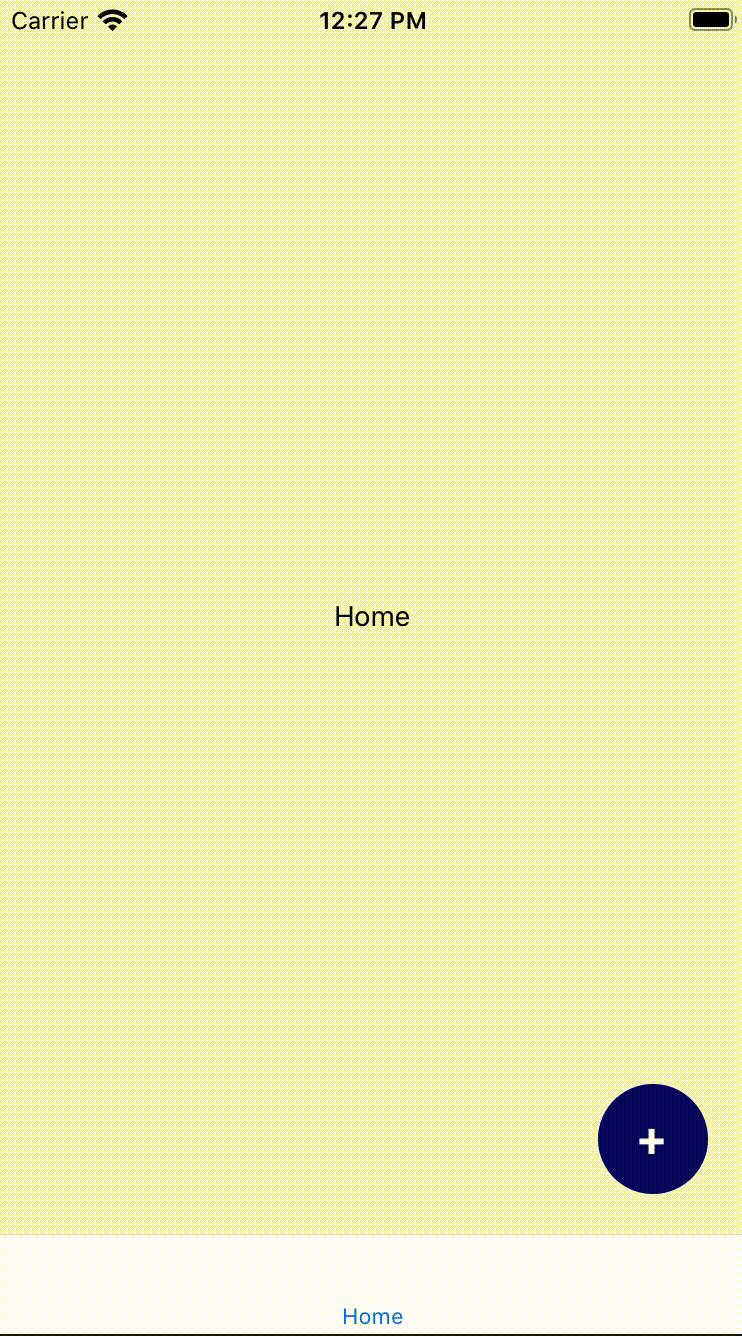
按钮动画
我们将缩放按钮,使其呈现出按钮变成屏幕的效果。我将使用 RN 中预置的 React Native 动画库。
in src/components/add-button/index.tsx
import { Animated } from 'react-native';
const AddButton = ({ onAdd } : AddButtonProps) => {
const [scaleValue] = useState(new Animated.Value(0));
const onButtonClicked = () => {
// Don't forget about the callback function for Animated.timing.
// After we finish scaling, we need to set the scale value back to 0;
// If we don't do that, when we go back to the Home screen our button will still be scaled
Animated.timing(scaleValue, {
toValue: 1,
useNativeDriver: true,
duration: 700,
}).start(() => { scaleValue.setValue(0); });
onAdd();
};
// You can test different input and output values.
// Just don't forget that inputRange is from 0 to 1 and outputRange starts from 1;
// These ranges looks the best for me
const scaleValueInterpolation = scaleValue.interpolate({
inputRange: [0, 0.25, 1],
outputRange: [1, 20, 30],
});
return (
<>
<Animated.View
style={[styles.container,
{ transform: [{ scale: scaleValueInterpolation }] },
]}
/>
<TouchableOpacity
style={styles.container}
onPress={onButtonClicked}
>
<Text style={styles.text}>
+
</Text>
</TouchableOpacity>
</>
);
};
export default AddButton;
为什么我没有把 TouchableOpacity 包裹在 Animated.View 中?我只是不想在 + 号上出现缩放效果。 对我来说,只有容器缩放看起来更好,所以我决定把动画缩放容器放在 TouchableOpacity 后面。 这是我们目前的结果:
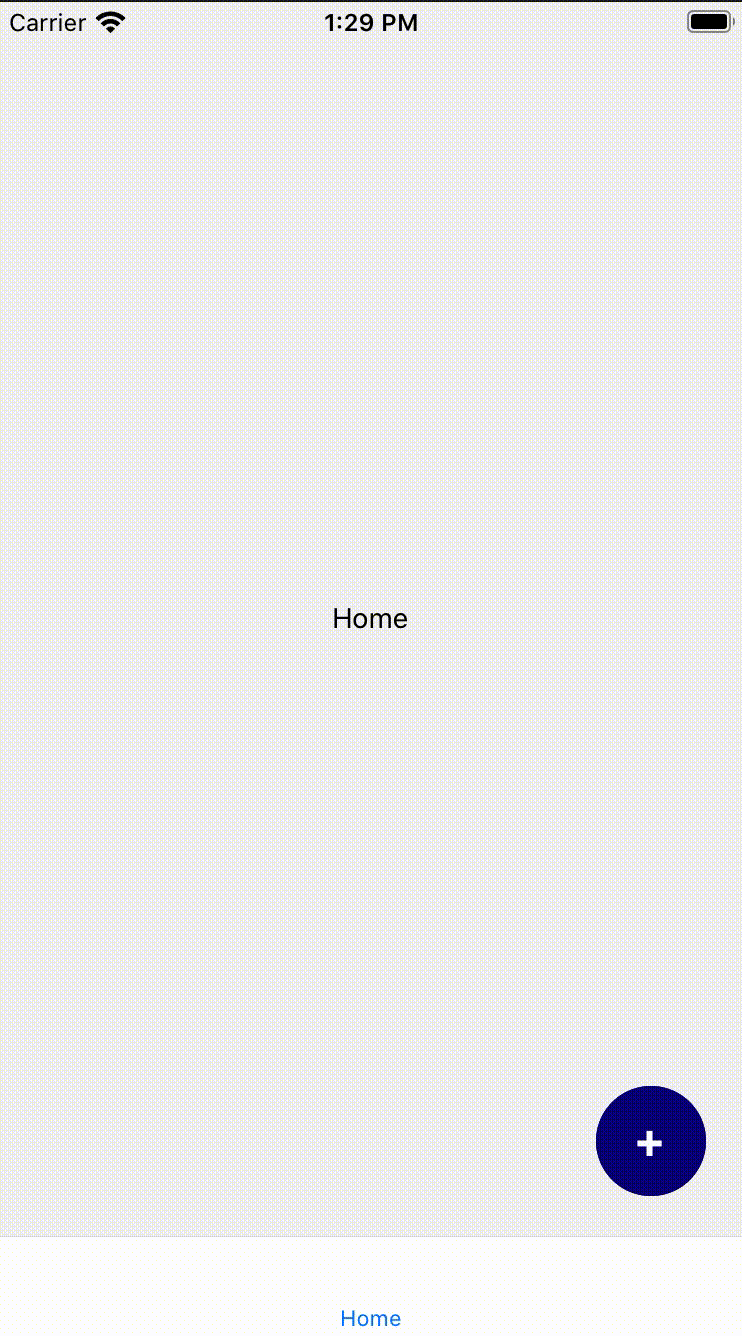
将 AddButton 放在标签栏中
正如我们在视频中看到的,按钮缩放动画没有与标签栏重叠,看起来不太美观。所以,让我们创建一个自定义标签栏,并将我们的 AddButton 组件放入其中。我将在src/components/tab-bar/index.tsx中创建 TabBar 组件:
import React from 'react';
import {
TouchableOpacity, StyleSheet, View, Text,
} from 'react-native';
import { BottomTabBarProps } from '@react-navigation/bottom-tabs';
import { SafeAreaView } from 'react-native-safe-area-context';
import AddButton from '../add-button';
const styles = StyleSheet.create({
tabButton: { flex: 1, justifyContent: 'center', alignItems: 'center' },
});
const TabBar = ({ state, descriptors, navigation } : BottomTabBarProps) => {
const onAdd = () => {
navigation.navigate('Modal');
};
return (
<>
{/* show the AddButton only if it's the first screen (Home screen) */}
{(state.index === 0) && (
<AddButton onAdd={onAdd} />
)}
<SafeAreaView style={{ backgroundColor: 'white' }}>
<View style={{ height: 55, flexDirection: 'row' }}>
{/* here we are mapping through the routes, defining its labels, configure the onPress functions */}
{state.routes.map((route, index) => {
const { options } = descriptors[route.key];
let label;
if (options.tabBarLabel === undefined) {
if (options.title === undefined) {
label = route.name;
} else { label = options.title; }
} else { label = options.tabBarLabel; }
const isFocused = state.index === index;
const onPress = () => {
const event = navigation.emit({
type: 'tabPress',
target: route.key,
canPreventDefault: true,
});
if (!isFocused && !event.defaultPrevented) {
navigation.navigate(route.name);
}
};
const onLongPress = () => {
navigation.emit({
type: 'tabLongPress',
target: route.key,
});
};
return (
<TouchableOpacity
accessibilityRole="button"
accessibilityState={isFocused ? { selected: true } : { selected: false }}
accessibilityLabel={options.tabBarAccessibilityLabel}
testID={options.tabBarTestID}
onPress={onPress}
onLongPress={onLongPress}
style={styles.tabButton}
key={route.key}
>
<Text style={{ color: isFocused ? 'navy' : 'grey' }}>
{label}
</Text>
</TouchableOpacity>
);
})}
</View>
</SafeAreaView>
</>
);
};
export default TabBar;
现在我们需要将自定义标签栏放入路由器中,并从 HomeScreen 中删除 AddButton。
// in App.tsx
...
const HomeScreen = () => (
<>
<View style={{ flex: 1, justifyContent: 'center', alignItems: 'center' }}>
<Text>Home</Text>
</View>
</>
);
...
const TabBarStack = createBottomTabNavigator<TabBarStackParamList>();
const TabBarStackScreen = () => (
<TabBarStack.Navigator tabBar={(props) => <TabBar {...props} />}>
<TabBarStack.Screen name="Home" component={HomeScreen} />
</TabBarStack.Navigator>
);
...
另外,我们现在需要将 AddButton 放得稍微高一点,因为我们应该考虑到 TabBar 的高度。
// in src/components/add-button/index.tsx
const styles = StyleSheet.create({
container: {
backgroundColor: 'navy',
width: 55,
height: 55,
borderRadius: 28,
position: 'absolute',
right: 20,
alignItems: 'center',
justifyContent: 'center',
// bottom: 20,
bottom: 75,
zIndex: 1,
elevation: 1,
},
});
快完成了!现在我们需要考虑 iPhone 10 及更高版本的机型,因为它们有不同的 insets,我们需要考虑到它们。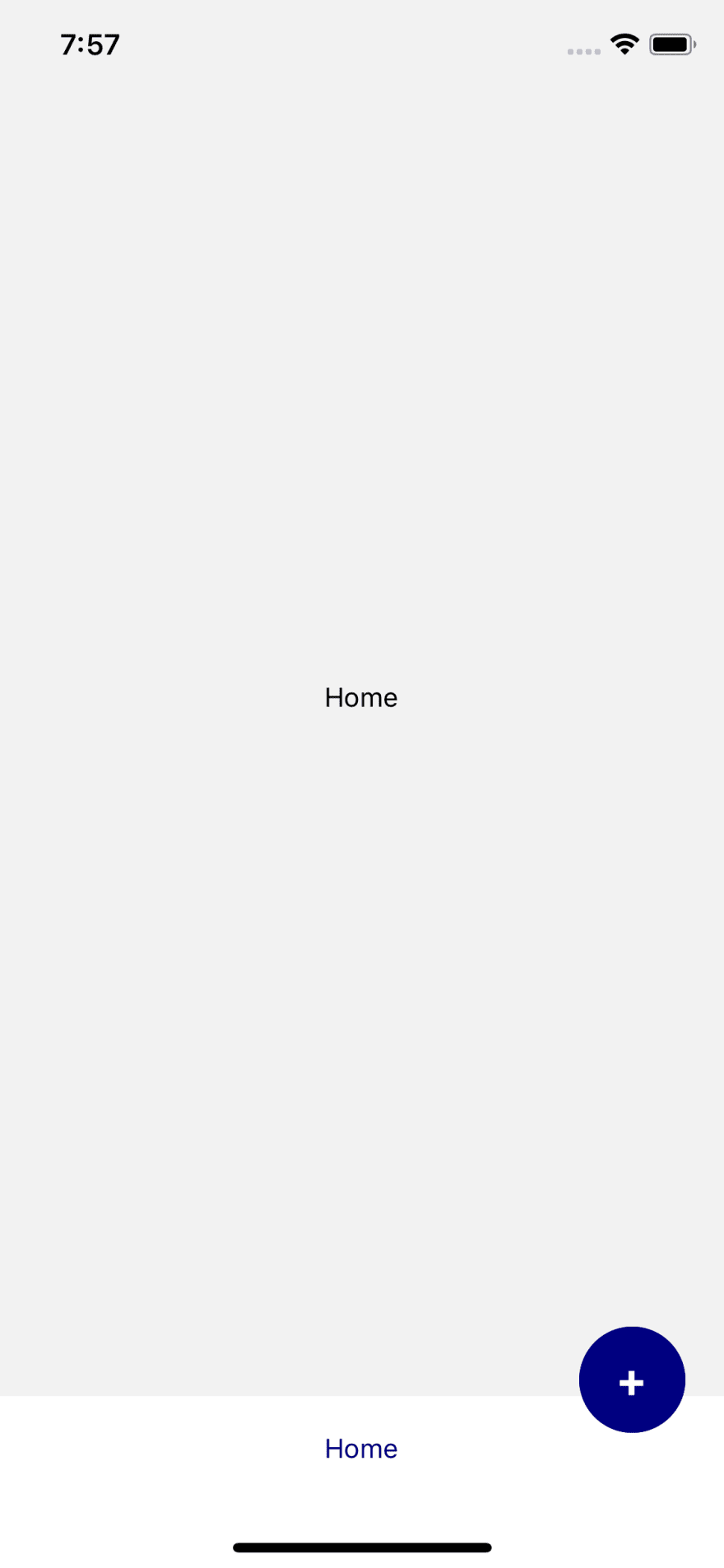
iPhone 10+ 的插图
为此,我们将使用已为 react-navigation 安装的 react-native-safe-area-context 创建一个名为 withInsets 的高阶组件。该库中的 SafeAreaConsumer 将为 iPhone 10+ 提供底部 insets。让我们在src/components/with-insets/index.tsx中创建一个新文件。
import React, { ComponentType } from 'react';
import { SafeAreaConsumer } from 'react-native-safe-area-context';
export type withInsetsProps = {
insets: {
bottom: number,
}
};
const withInsets = (BaseComponent: ComponentType<any>) => (props: any) => (
<SafeAreaConsumer>
{(insets) => (
<BaseComponent
insets={{ bottom: insets?.bottom }}
{...props}
/>
)}
</SafeAreaConsumer>
);
export default withInsets;
现在我们需要用 withInsets 包装我们的 TabBar 组件并将 insets 传递给 AddButton:
// in src/components/tab-bar/index.tsx
...
import withInsets, { withInsetsProps } from '../with-insets';
...
export type TabBarProps = BottomTabBarProps & withInsetsProps;
const TabBar = ({
state, descriptors, navigation, insets,
} : TabBarProps) => {
...
return (
{(state.index === 0) && (
<AddButton onAdd={onAdd} bottomInset={insets.bottom} />
)}
...
)
};
export default withInsets(TabBar);
下一步是在我们的 AddButton 组件中添加此插图:
// in src/components/add-button/index.tsx
...
type AddButtonProps = {
onAdd: () => void,
bottomInset: number
}
const AddButton = ({ onAdd, bottomInset } : AddButtonProps) => {
...
return (
<>
<Animated.View
style={[styles.container,
{
transform: [{ scale: scaleValueInterpolation }],
bottom: 70 + bottomInset,
},
]}
/>
<TouchableOpacity
style={[styles.container, { bottom: 70 + bottomInset }]}
onPress={onButtonClicked}
>
<Text style={styles.text}>
+
</Text>
</TouchableOpacity>
</>
);
};
export default AddButton;
 后端开发教程 - Java、Spring Boot 实战 - msg200.com
后端开发教程 - Java、Spring Boot 实战 - msg200.com
